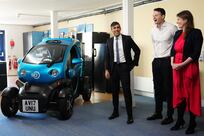DUBAI // Rami Hamad put his hand out towards the calf. As it approached, he mooed.
"They don't have any teeth so they won't bite," said the manager of Al Rawabi Dairy's farm in Dubai. To his delight, the calf mooed back.
"After a year and a half of working at the farm, I know how to speak to them and they understand me," he said with a smile.
Mr Hamad is working flat out as the UAE's biggest dairy farm prepares to take delivery of 3,000 new cows from the Netherlands, expanding and renovating its facilities for the influx.
The Al Rawabi farm in Al Khawaneej has come a long way since 1991, when it started with 500 cows producing 10,000 litres of fresh milk a day. It now has about 7,000 cattle, and by next year that figure is expected to be more like 12,000.
Seven new sheds will be built to accommodate the Dutch imports, which are due to arrive in December. They will be about two years old.
Adding Dutch cows to the existing Australian stock is a deliberate move, Mr Hamad said.
"We want to change genetics," he said. "Australian cows are healthy but not great producers, whereas cows from Holland are good producers - so we want to mix them."
The UAE's demand for dairy products soared in the past year, with the demand for milk up by 11 per cent and rising, says Abyson Jacob, the company's marketing manager.
"The population in the UAE is currently consuming on average 125 million litres of milk," said Mr Jacob. Last year, that number stood at 111 million litres.
To get the most from the extra cows, the farm will expand its milking capacity by between 15 million and 20 million litres a year, extend its milking parlour by 11 metres and build a new parlour next door.
Two yards have been emptied to allow a new cooling system to be installed for half of the farm's 35 cattle houses and the seven under construction.
"Better cooling for the cows means more milk," said Mr Hamad, adding the coolers also keep bacteria at bay. "When the coolers are put in, it'll be much cleaner."
Part of the renovation includes an opening, one metre wide, running across the roof of each to improve ventilation - an initiative that started a month ago.
A new area in a separate shed houses 1,000 Australian calves - each tagged with its date of birth, sex and a number.
Kept cool by hundreds of mist-spraying fans, they will remain there until they are two months old, when they will move to a new area for young stock.
They stay there until they are 14 months old, when they are artificially inseminated. Finally they start milking at between 22 and 24 months old.
The cows' water troughs will be moved inside each house to lure them into the shade.
The passageways leading to the milking parlour will have sensors that open the doors automatically when cows approach.
"All our work is based on cow comfort," said Mr Hamad. "There will be a new computerised feeding system where all the cows' information will be stored and monitored."
Each cow's production will be metered, making it easier to identify which cows are milking well and which might have some sort of health problem.
The refurbishments are due to be completed by May 1.
After that, Al Rawabi is considering plans for new farms in Qatar and Kuwait, again with cows imported from the Netherlands.






